The Nightshirt Guide to the Twin Peaks Rebirth
“We live in a world of opposites, of extreme evil and violence opposed to goodness and peace. It’s that way here for a reason but we have a hard time grasping what the reason is. In struggling to understand the reason, we learn about balance and there’s a mysterious door right at that balance point. We can go through that door anytime we get it together.” — David Lynch
“Luminous beings are we, not this crude matter.” — Yoda
With the new incarnation of Twin Peaks, David Lynch is inviting obsessive scrutiny, as always. That scrutiny is paying off in all kinds of ways … although it is unclear how much of it is distraction, bones being tossed to the most obsessive fans, and how much is essential for “getting” his remarkable series. I think it’s about half and half.
Lynch’s specific concern is the things that can go wrong or amiss in the spiritual economy of (re)birth.
As strange as what we’ve seen so far is—especially the astonishing, destined-to-be-legendary Episode 8 (spoilers ahead, obviously)—I am surprised at how explicit and clear Lynch is being about some of the themes and ideas that he used to make us guess at. We now actually have concrete answers to some of the biggest questions that always hovered over Twin Peaks‘ world, such as: How did the evil spirit Bob got here, and when? What is the “fire” that the spirits want us to walk with? If I have any slight worry about where this is all going, it is that we might know too much by the time it’s over, rather than being left with myriad questions, the usual Lynch experience. (But it’s not a big worry.)
 Some of the hidden stuff I feel sure is just there just to beguile the obsessed. For instance one fan has discovered that of all things the flashing windows in the jet carrying Gordon Cole et al to South Dakota in Episode 7 is not sun reflection but was added digitally, creating some kind of code … but what? I won’t go down this rabbit hole, or anything numerical; I have no head for numbers. There are other lures in the form of numerical sequences: The “15” that becomes a “3” on the electrical reincarnation machine in the rebirthing lounge in Episode 3, for instance (seen here). I have no clue what that means either (unless something is going to happen in Episode 15 that links to it). [Update 6/29/17: Michael M. Hughes notes in his comment that 315 was Dale Cooper’s room at the Great Northern, as seen on his green room key.] Nor do I know about the numbers (“One one nine!!”) blurted out by the mostly unconscious drug-addicted mom in the Rancho Rosa development (is it just 911 in reverse?).
Some of the hidden stuff I feel sure is just there just to beguile the obsessed. For instance one fan has discovered that of all things the flashing windows in the jet carrying Gordon Cole et al to South Dakota in Episode 7 is not sun reflection but was added digitally, creating some kind of code … but what? I won’t go down this rabbit hole, or anything numerical; I have no head for numbers. There are other lures in the form of numerical sequences: The “15” that becomes a “3” on the electrical reincarnation machine in the rebirthing lounge in Episode 3, for instance (seen here). I have no clue what that means either (unless something is going to happen in Episode 15 that links to it). [Update 6/29/17: Michael M. Hughes notes in his comment that 315 was Dale Cooper’s room at the Great Northern, as seen on his green room key.] Nor do I know about the numbers (“One one nine!!”) blurted out by the mostly unconscious drug-addicted mom in the Rancho Rosa development (is it just 911 in reverse?).
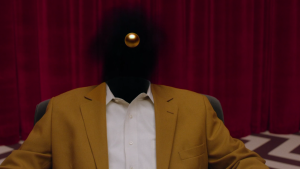 Color seems to be a code here too—the color gold, for instance. We’ve never seen so much gold in a Lynch work—it feels almost gaudy coming from him—and note its prevalence particularly in Episode 3 around Good Cooper’s debut into the real world. Jade’s jeep, the casino, the sport jacket Dougie is wearing before he goes poof (right) and the gold ball he turns into; also Dr. Jacoby’s gold-painted shovels. For the alchemists, “gold” meant (you guessed it) rebirth. The purple color of the rebirth ocean/planet (below) is also interesting, with possible reference to the “astral plane,” often associated with the color purple. There is a lot of Theosophical or pseudo-Theosophical stuff going on here, as we’ll see.
Color seems to be a code here too—the color gold, for instance. We’ve never seen so much gold in a Lynch work—it feels almost gaudy coming from him—and note its prevalence particularly in Episode 3 around Good Cooper’s debut into the real world. Jade’s jeep, the casino, the sport jacket Dougie is wearing before he goes poof (right) and the gold ball he turns into; also Dr. Jacoby’s gold-painted shovels. For the alchemists, “gold” meant (you guessed it) rebirth. The purple color of the rebirth ocean/planet (below) is also interesting, with possible reference to the “astral plane,” often associated with the color purple. There is a lot of Theosophical or pseudo-Theosophical stuff going on here, as we’ll see.
 But another code I’ve detected, and that bears greater exploration I think, consists of a series of interesting cinematic allusions. Lynch seems to be deliberately indexing both his own films but also an assortment of other directors’ works in a somewhat systematic way. Some are the usual suspects like Kubrick; others, though odd on the surface, make greater sense on examination.
But another code I’ve detected, and that bears greater exploration I think, consists of a series of interesting cinematic allusions. Lynch seems to be deliberately indexing both his own films but also an assortment of other directors’ works in a somewhat systematic way. Some are the usual suspects like Kubrick; others, though odd on the surface, make greater sense on examination.
Since I have not seen this “intertextual code” talked about yet, I’m offering it here as my own contribution to the collective fan exegesis, for what it may be worth, along with consideration of the paranormal mythemes Lynch is developing in this breakthrough show.
Lynch is the Monolith and the Ape; Drink Deep, and Descend
Remember that Lynch is a lover of cinema and its history, and has always indexed and referenced other films quite explicitly. He deliberately referenced Ingmar Bergman’s Persona in Mulholland Drive, for instance. So it’s really not surprising he’s doing it again in Twin Peaks. But I think he may be doing it here not only systematically but also semantically—sending a message with some of these film references, not just paying homage to directors he likes.
In the bardo, you can get re-routed and detained, you encounter really creepy beings, and there seem to be multiple levels or staging areas through which you must pass. You wander through it in a daze.
The most obvious references are to films by Kubrick, especially 2001. I think 2001 is the biggest single key to Lynch’s work, especially the final segment “Jupiter and Beyond the Infinite.” Most of Lynch’s films, starting with Eraserhead and Elephant Man and continuing with Twin Peaks and his films of the 1990s and 2000s (everything but Dune, Blue Velvet, and Wild at Heart, essentially), could be seen as “themes and variations” on what happens to Dave Bowman after he passes through the Jovian stargate and becomes the Star Child. (And appropriately enough, a good indicator of whether a person likes Lynch is whether they think 2001 is the most brilliant thing ever or is just meaningless psychedelia. You know where I stand: Don’t be that one man-ape off in back, picking his nose, who doesn’t take any interest in the slab—it’s there to evolve you. Go up and touch it.)
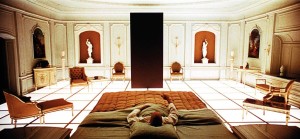 The various rooms we’ve seen so far in the ‘Rebirth Fortress’ (my name for the place where the technology of reincarnation seems to be housed, and where its caretakers seem to live) on the Purple Planet are very much like the hotel suite in 2001—ambiguous, weirdly “terrestrial” and “historical” places of transition prior to rebirth. I was particularly struck that when we enter the fortress in Episode 8, it is via a black aperture that looks exactly like the 2001 monolith. This is deliberate, and Lynch’s most explicit indicator yet that 2001 is his touchstone for all this.
The various rooms we’ve seen so far in the ‘Rebirth Fortress’ (my name for the place where the technology of reincarnation seems to be housed, and where its caretakers seem to live) on the Purple Planet are very much like the hotel suite in 2001—ambiguous, weirdly “terrestrial” and “historical” places of transition prior to rebirth. I was particularly struck that when we enter the fortress in Episode 8, it is via a black aperture that looks exactly like the 2001 monolith. This is deliberate, and Lynch’s most explicit indicator yet that 2001 is his touchstone for all this.
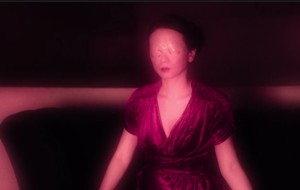 It’s not about Jupiter of course; it’s about what in Tibetan religion—or the faux Tibetan religion delivered by Theosophist Walter Evans-Wentz—is called the bardo, the dimension or plane between lives. Lynch’s specific concern is the things that can go wrong or amiss in the spiritual economy of (re)birth. In the bardo, you can get re-routed and detained, you encounter really creepy beings, and there seem to be multiple levels or staging areas through which you must pass. Nothing makes much sense, and you wander through it in a daze.
It’s not about Jupiter of course; it’s about what in Tibetan religion—or the faux Tibetan religion delivered by Theosophist Walter Evans-Wentz—is called the bardo, the dimension or plane between lives. Lynch’s specific concern is the things that can go wrong or amiss in the spiritual economy of (re)birth. In the bardo, you can get re-routed and detained, you encounter really creepy beings, and there seem to be multiple levels or staging areas through which you must pass. Nothing makes much sense, and you wander through it in a daze.
Kubrick’s own examination of the problem of rebirth and its vicissitudes was The Shining—which he made under the direct influence of Lynch’s Eraserhead (he made the cast watch it); and The Shining in turn was a major influence on Twin Peaks and Lynch’s subsequent work. The various rebirths/possessions through caretaker after caretaker in the Overlook Hotel are a template for the various incarnations of Bob. The Black Lodge with its red curtains is not only like the hotel/bardo of 2001 but also like a “redrum” (i.e., red room).
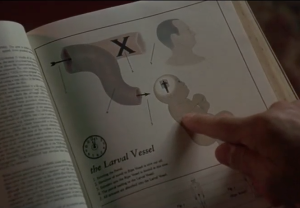 There are other films Lynch is explictly signaling, such as Spike Jonze’s Being John Malkovich. From the first, Dougie’s boss, Bushnell Mullins, a former boxer and founder/owner of “Lucky 7 Insurance,” gave me a strong vibe of Orson Bean as the eccentric Dr. Lester, president of the filing service LesterCorp on the 7 1/2th Floor of the Mertin-Flemmer Building in New York City. Mullins’ interest in Dougie’s cryptic scribbles on the stack of files he had assigned Dougie to work on at home clinched this connection for me. The allusion to Dr. Lester in Jonze’s film is, I think, deliberate: In Being John Malkovich, Lester is a nearly expired “vessel body” for the spirit of the original founder of the company, Captain Mertin, and at one point in the movie we see old diagrams in a book in his home, recalling Theosophy-esque theorizing about “larval vessels” and “ripe vessels” and the transmigration of souls from one body to another. Of all films by other directors, Being John Malkovich captures the essence of what all of Lynch’s oeuvre, and especially Twin Peaks, is about. I doubt it is accidental that John Malkovich himself “channeled” Lynch and the various characters from Twin Peaks a few years ago in a short film. (It’s not very impressive, in my opinion—John Malkovich can’t not seem like John Malkovich. Although maybe that’s the joke.)
There are other films Lynch is explictly signaling, such as Spike Jonze’s Being John Malkovich. From the first, Dougie’s boss, Bushnell Mullins, a former boxer and founder/owner of “Lucky 7 Insurance,” gave me a strong vibe of Orson Bean as the eccentric Dr. Lester, president of the filing service LesterCorp on the 7 1/2th Floor of the Mertin-Flemmer Building in New York City. Mullins’ interest in Dougie’s cryptic scribbles on the stack of files he had assigned Dougie to work on at home clinched this connection for me. The allusion to Dr. Lester in Jonze’s film is, I think, deliberate: In Being John Malkovich, Lester is a nearly expired “vessel body” for the spirit of the original founder of the company, Captain Mertin, and at one point in the movie we see old diagrams in a book in his home, recalling Theosophy-esque theorizing about “larval vessels” and “ripe vessels” and the transmigration of souls from one body to another. Of all films by other directors, Being John Malkovich captures the essence of what all of Lynch’s oeuvre, and especially Twin Peaks, is about. I doubt it is accidental that John Malkovich himself “channeled” Lynch and the various characters from Twin Peaks a few years ago in a short film. (It’s not very impressive, in my opinion—John Malkovich can’t not seem like John Malkovich. Although maybe that’s the joke.)
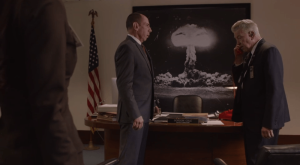 The next one, a Woody Allen reference of all things, will seem odd, but bear with me. After Episode 8, we know that Gordon Cole’s huge photo of a mushroom cloud behind his desk signals his knowledge that the bomb is directly connected to the “Blue Rose” (supernatural) cases that are his special interest. Turns out it was specifically the Trinity test on July 16, 1945 that ripped open the barrier between worlds that let an evil host through. Bob and his evil ilk are seen vomited forth by the evil white figure (see below) who was glimpsed devouring the couple on the couch in Episode 2, in front of the glass box; Bob is shown clearly as this spirit-mother’s darkest progeny. The fire the evil spirits want us to walk with is nuclear fire. Famously, the Manhattan Project’s leader, J. Robert Oppenheimer, later quoted the Bhagavad-Gita in reference to what they had wrought: “I am become death, destroyer of worlds.”
The next one, a Woody Allen reference of all things, will seem odd, but bear with me. After Episode 8, we know that Gordon Cole’s huge photo of a mushroom cloud behind his desk signals his knowledge that the bomb is directly connected to the “Blue Rose” (supernatural) cases that are his special interest. Turns out it was specifically the Trinity test on July 16, 1945 that ripped open the barrier between worlds that let an evil host through. Bob and his evil ilk are seen vomited forth by the evil white figure (see below) who was glimpsed devouring the couple on the couch in Episode 2, in front of the glass box; Bob is shown clearly as this spirit-mother’s darkest progeny. The fire the evil spirits want us to walk with is nuclear fire. Famously, the Manhattan Project’s leader, J. Robert Oppenheimer, later quoted the Bhagavad-Gita in reference to what they had wrought: “I am become death, destroyer of worlds.”
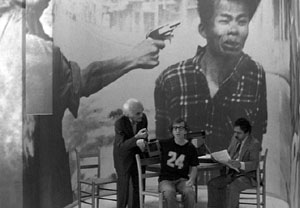 But before we knew this connection, the photo also recalled Woody Allen’s character Sandy Bates in his 1980 homage to Fellini, Stardust Memories. Bates is a film director anxious over his current production (like Marcello Mastroianni’s character in 8 1/2), and to reflect his dark mood his apartment is dominated by a gigantic blow-up of the famous b/w photograph of a South Vietnamese officer executing a Vietcong prisoner, as a reminder of the world’s darkness and atrocity. The significance of this reference may be nothing more than to subliminally activate the phrase “stardust memories” in a viewer who remembers that film—i.e., memories of our past life or origins in the stars (but see below).
But before we knew this connection, the photo also recalled Woody Allen’s character Sandy Bates in his 1980 homage to Fellini, Stardust Memories. Bates is a film director anxious over his current production (like Marcello Mastroianni’s character in 8 1/2), and to reflect his dark mood his apartment is dominated by a gigantic blow-up of the famous b/w photograph of a South Vietnamese officer executing a Vietcong prisoner, as a reminder of the world’s darkness and atrocity. The significance of this reference may be nothing more than to subliminally activate the phrase “stardust memories” in a viewer who remembers that film—i.e., memories of our past life or origins in the stars (but see below).
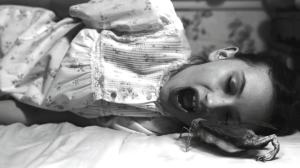 On the opposite wall of Cole’s office is another big photo most would find depressing: Franz Kafka. The first free association that comes to mind for me and I assume many people would be the word “metamorphosis”—a man reborn as a bug (most imagine a cockroach, but in the original German it is mistkafer, a dung beetle or scarab, symbol of rebirth). In Episode 8, the Giant (or, the Giant’s father?), one of the caretakers in the Rebirth Fortress, dismayed at nuclear developments on Earth and alarmed at seeing Bob en route, sends his own spirit or seed to combat that evil force. The next scene, taking place in 1956, shows a frog-like winged insect hatching from a meteorite egg, which crawls into the body of a girl, no doubt to possess or impregnate her.
On the opposite wall of Cole’s office is another big photo most would find depressing: Franz Kafka. The first free association that comes to mind for me and I assume many people would be the word “metamorphosis”—a man reborn as a bug (most imagine a cockroach, but in the original German it is mistkafer, a dung beetle or scarab, symbol of rebirth). In Episode 8, the Giant (or, the Giant’s father?), one of the caretakers in the Rebirth Fortress, dismayed at nuclear developments on Earth and alarmed at seeing Bob en route, sends his own spirit or seed to combat that evil force. The next scene, taking place in 1956, shows a frog-like winged insect hatching from a meteorite egg, which crawls into the body of a girl, no doubt to possess or impregnate her.
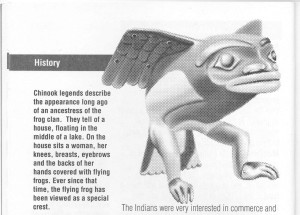 [The following updated 6/29/17 in light of reader comments.] Is the bug the terrestrial manifestation of the Giant and is the girl destined to be a savior figure? Is she Sarah Palmer, Laura’s Mom? (We saw Laura’s face in the Giant’s orb before his wife(?) sends it on its way to Earth, although 1956 is still about a decade and a half too early for Laura’s ‘conception.’) Or is the bug the larval form of Bob or one of his brethren, whose eggs were also seen in the ectoplasmic vomit spewed by the ‘spirit mother’? Whatever the case, we are likely to see a Kafkaesque transformation at some point. After the episode aired, Daniel McGachey (@DMcGachey) tweeted the picture above, from a 1991 book Twin Peaks: An Access Guide to the Town. It is clearly the source for the creature. The text describes a Chinook legend about “the ancestress of the Frog Clan” who was covered with these winged frog creatures. If any readers have any further information about this bit of mythology, or know if it is genuine, please let me know in comments.
[The following updated 6/29/17 in light of reader comments.] Is the bug the terrestrial manifestation of the Giant and is the girl destined to be a savior figure? Is she Sarah Palmer, Laura’s Mom? (We saw Laura’s face in the Giant’s orb before his wife(?) sends it on its way to Earth, although 1956 is still about a decade and a half too early for Laura’s ‘conception.’) Or is the bug the larval form of Bob or one of his brethren, whose eggs were also seen in the ectoplasmic vomit spewed by the ‘spirit mother’? Whatever the case, we are likely to see a Kafkaesque transformation at some point. After the episode aired, Daniel McGachey (@DMcGachey) tweeted the picture above, from a 1991 book Twin Peaks: An Access Guide to the Town. It is clearly the source for the creature. The text describes a Chinook legend about “the ancestress of the Frog Clan” who was covered with these winged frog creatures. If any readers have any further information about this bit of mythology, or know if it is genuine, please let me know in comments.
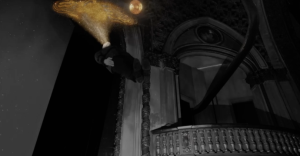 With the pictures in his office, Lynch (as Gordon Cole) seems to be signaling not only the origin of evil in our world but also possibly a pathway to redemption. The fact that the Giant and his wife—keepers of the fortress, presumably—interact with earth via a kind of newsreel projection also calls to mind cinema as the interface or mediator of rebirth. Also, as the giant’s suspended body is generating his seed/egg, his head produces a shower of golden sparkles, like stardust. After the orb is beheld and kissed by the Giant’s wife, a golden machine (@Dharmapoppins aptly compares it to a fallopian tube) projects the three-dimensional “golden orb” into the flat newsreel picture, where it then makes its way to Earth. The movie screen as uterus.
With the pictures in his office, Lynch (as Gordon Cole) seems to be signaling not only the origin of evil in our world but also possibly a pathway to redemption. The fact that the Giant and his wife—keepers of the fortress, presumably—interact with earth via a kind of newsreel projection also calls to mind cinema as the interface or mediator of rebirth. Also, as the giant’s suspended body is generating his seed/egg, his head produces a shower of golden sparkles, like stardust. After the orb is beheld and kissed by the Giant’s wife, a golden machine (@Dharmapoppins aptly compares it to a fallopian tube) projects the three-dimensional “golden orb” into the flat newsreel picture, where it then makes its way to Earth. The movie screen as uterus.
Hal Ashby’s great film Being There is another obvious reference for this series. Good Cooper (as Dougie Jones) ambles through life like the childlike gardener Chance (Peter Sellers). Like Chance, Cooper/Dougie is at this point a blank cipher on which other people project what they want to see/hear, and they guide him to success inadvertently. It is significant that “chance” as in luck (e.g., “Lucky 7 Insurance” and his luck at the casino, or in evading the hitmen) is so much a part of Good Cooper’s story at this point. Again, Lynch may simply be referencing the phrase “being there,” as in “be there” or “be here now”—i.e., be present in your life.
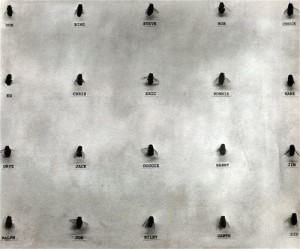 Lynch is also explicitly citing/alluding to his own works. This could easily turn into a long rabbit hole but I’ll just mention a few: “Dougie” for instance is name of the central “Rickie” in Lynch’s most famous “Rickie Board,” his 1994 Bee Board. The idea is to make a 4 by 5 array of identical objects or “Rickies”—Lynch most often used drawings of or actual dead insects like flies—and put a different name under each of them. An amazing effect is produced that each identical insect comes to take on a distinct personality because of its name. The reborn, amnesic Dale Cooper is a bit like a Rickie, a cipher being given shape and form by the name “Dougie” people use for him.
Lynch is also explicitly citing/alluding to his own works. This could easily turn into a long rabbit hole but I’ll just mention a few: “Dougie” for instance is name of the central “Rickie” in Lynch’s most famous “Rickie Board,” his 1994 Bee Board. The idea is to make a 4 by 5 array of identical objects or “Rickies”—Lynch most often used drawings of or actual dead insects like flies—and put a different name under each of them. An amazing effect is produced that each identical insect comes to take on a distinct personality because of its name. The reborn, amnesic Dale Cooper is a bit like a Rickie, a cipher being given shape and form by the name “Dougie” people use for him.
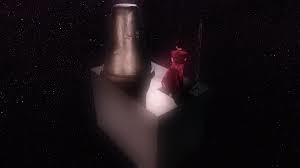 Then there’s Eraserhead, of course: The fortress on the Purple Planet through which souls pass on their way to rebirth has a definite Eraserhead vibe. Remember the “Man in the Planet” who pulls a lever and releases the sperm-like seeds that become the deformed baby. Much of Episode 3 (the space box with its lever) and Episode 8 recall this Gnostic mechanism of cosmic insemination and rebirth. That film of course is about “things that can go wrong with birth,” a theme Lynch also revisited in his next film, Elephant Man.
Then there’s Eraserhead, of course: The fortress on the Purple Planet through which souls pass on their way to rebirth has a definite Eraserhead vibe. Remember the “Man in the Planet” who pulls a lever and releases the sperm-like seeds that become the deformed baby. Much of Episode 3 (the space box with its lever) and Episode 8 recall this Gnostic mechanism of cosmic insemination and rebirth. That film of course is about “things that can go wrong with birth,” a theme Lynch also revisited in his next film, Elephant Man.
And of course there is Mulholland Drive. I’ve written before about the importance of The Cowboy as a stand-in for Lynch in his most scolding, preacher mode: Stop bein’ a smart-aleck and pay attention, is what Lynch’s ultimate message for us full-of-ourselves, wise-ass humans is. Well, the other message The Cowboy delivers in that film is “time to wake up.” It is interesting that Lynch has cast Naomi Watts as the bewildered/protective wife of the befuddled Dougie—essentially reprising her role as the innocent rescuer/helper of the amnesic Rita in Mulholland Drive—and that their son, “Sonny Jim,” is in his obsessions (and flickering on/off lamp) a cowboy. The moving scene in Episode 4 when Cooper/Dougie stares at Sonny Jim in the driveway and begins to cry represents his beginning to wake up, and I imagine we can expect Sonny Jim to play a further role in Dale Cooper’s process of awakening, possibly in Episode 9.
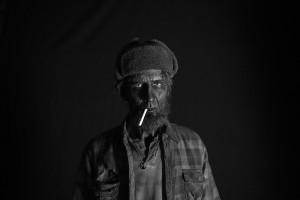 The shambling, soot-faced evil spirits that swarm in and around the famous Convenience Store (above which Mike once lived with Bob in their killin’ days) are reminiscent of the evil presence behind Winky’s diner in Mulholland Drive. “The Woodsman” who we met in Episode 8 and wants a light, kills the folks at the radio station, and hypnotizes the New Mexico town with his chant about the water and the well, etc., is like the creature behind Winky’s crossed with Abraham Lincoln (speaking in a voice that uncannily sounds like John Huston’s Gandalf in the 1977 Rankin Bass version of The Hobbit, which added a further dimension of strangeness for me). Turns out that not long before they filmed Twin Peaks, the actor who plays the Woodsman was also in a very short, very funny film called Linclone, about an evil clone of Lincoln, so there you go.
The shambling, soot-faced evil spirits that swarm in and around the famous Convenience Store (above which Mike once lived with Bob in their killin’ days) are reminiscent of the evil presence behind Winky’s diner in Mulholland Drive. “The Woodsman” who we met in Episode 8 and wants a light, kills the folks at the radio station, and hypnotizes the New Mexico town with his chant about the water and the well, etc., is like the creature behind Winky’s crossed with Abraham Lincoln (speaking in a voice that uncannily sounds like John Huston’s Gandalf in the 1977 Rankin Bass version of The Hobbit, which added a further dimension of strangeness for me). Turns out that not long before they filmed Twin Peaks, the actor who plays the Woodsman was also in a very short, very funny film called Linclone, about an evil clone of Lincoln, so there you go.
Gotta Guiding Light?
In all his interviews and published writings, Lynch projects an image of himself as a “pure artist,” right-brained, somewhat inarticulate about the meaning of his work (or unwilling to speak about it) but full of folksy wisdom. When Mitch Horowitz asked Lynch in a recent excellent radio interview (produced by my wife Laura Kwerel, so that’s a plug) whether he’d ever seen a ghost or a UFO, he said “No I haven’t” and did not elaborate. But clearly he (along with Mark Frost, his cowriter) knows a lot about the paranormal and the occult. And with the new Twin Peaks, Lynch is more clearly than ever telling a spiritual story via the medium of paranormal science fiction. Where the original series was like an occult-inflected soap opera, this one is turning into something much more epic, like a comic book, complete with superpowers and origin stories. Thus a great lens through which to view this unprecedented TV event is the work of Jeffrey Kripal, who mapped the core mythemes of the paranormal “super story” in his books Mutants and Mystics and The Super Natural.
With the new Twin Peaks, Lynch is more clearly than ever telling a spiritual story via the medium of paranormal science fiction.
Most obviously there is the “mytheme of radiation.” Ever since Lynch’s earliest work and especially in all the incarnations of Twin Peaks, energy in the form of electricity is the carrier of spirit. Lynch is obsessed with flickering lights, bad connections, old bakelite lamps and clocks, and power lines. In both Fire Walk With Me and the beautiful/devastating Episode 6 of the new series, Harry Dean Stanton’s character Carl has visions associated with the power lines that hang unnoticed over the streets of his town. And when Dale Cooper is reborn through an electrical outlet in an empty Rancho Rosa home, I was thinking: Lynch must have been reading Kripal. The strange pylons in the Fortress of Rebirth and on the space box in Episode 3 are somehow transformers of electrical-spiritual energy. Somehow, the rebirth system on our planet utilizes or co-opts human technology.
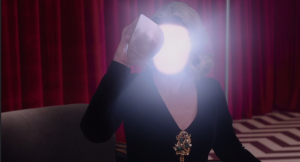 In this Twin Peaks incarnation, Lynch is also showing us more explicitly what he thinks about light as such. Early on, Laura Palmer in the Black Lodge pulls aside her face to reveal to Dale Cooper that she is a creature of light. Carl watches dumbstruck as the golden soul of the boy killed by Richard Horne’s truck ascends to the power lines above, where presumably he will be rerouted to some central reincarnational transformer. Lynch is showing his spiritual hand in this series more than ever before. As Yoda tells Luke Skywalker in The Empire Strikes Back, “Luminous beings are we, not this crude matter.” Lynch clearly agrees with Yoda. Lynch may be Yoda.
In this Twin Peaks incarnation, Lynch is also showing us more explicitly what he thinks about light as such. Early on, Laura Palmer in the Black Lodge pulls aside her face to reveal to Dale Cooper that she is a creature of light. Carl watches dumbstruck as the golden soul of the boy killed by Richard Horne’s truck ascends to the power lines above, where presumably he will be rerouted to some central reincarnational transformer. Lynch is showing his spiritual hand in this series more than ever before. As Yoda tells Luke Skywalker in The Empire Strikes Back, “Luminous beings are we, not this crude matter.” Lynch clearly agrees with Yoda. Lynch may be Yoda.
But there is also the Trinity mushroom cloud, and the Kubrick-esque journey inside it—one of the most beautiful visions I’ve ever seen on TV or in film, and a concrete historical reference I never quite expected from Lynch. Clearly this is a bad form of “radiation” that allows an unprecedented evil to gain access to our planet.
“Mutation” is another obvious mytheme throughout Lynch’s work, of course, and is the obvious result of radiation. Physical mutation describes the idea of “(re)birth gone awry,” beginning with Eraserhead and Elephant Man and Balthasar Getty’s character in Lost Highway (“reborn” with strange bumps on his head), not to mention the “evolution of the arm” (see below) and the various human body types and shapes (extremely fat, extremely thin, giants, dwarves, etc.) that appear throughout his work. In the new Twin Peaks I’m marveling at the interesting-looking actors Lynch has found to work with: people with Neandertal-esque brow ridges (Ray), weirdly sloping foreheads (the evil Richard Horne), and so on.
But then there is mutation as in “rebirth with superpowers,” and it is Good Cooper/Dougie who is showing us this new, more extravagantly sci-fi/comic-book side of Lynch. Cooper navigates the casino, seeing “Black Lodge icons” over the slot machines (“one-armed bandits,” colloquially—more on “arms” below) that will pay a jackpot; a green light flashing on coworker Anthony’s face tells him the man is lying; and lights on his “homework” guide his pencil. It is a kind of sixth sense or precognition manifesting—as it often does in real life—as literal “guiding lights.”
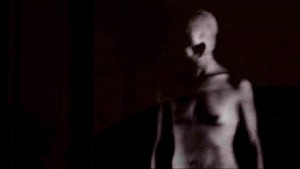 And there is the “mytheme of alienation.” This has been present from the start of the original series: Who are these entities in the Black Lodge? But it is becoming more and more explicit that they are not from or of our world, but that our own technology has allowed them to gain access. I have always wished Lynch would tell a full-on sci-fi story (forgetting Dune, of course), and now I am getting my wish. The amphibian-beetle from a meteorite egg in the New Mexico desert (which then crawls into the mouth of the sleeping girl) is the most explicitly “alien” creature Lynch has ever created, with the possible exception of the baby in Eraserhead. Then of course there is the eyeless ‘spirit mother’ (above). Lynch is more boldly saying that these “spirits” are really alien. They are not just projections of our own shadow selves.
And there is the “mytheme of alienation.” This has been present from the start of the original series: Who are these entities in the Black Lodge? But it is becoming more and more explicit that they are not from or of our world, but that our own technology has allowed them to gain access. I have always wished Lynch would tell a full-on sci-fi story (forgetting Dune, of course), and now I am getting my wish. The amphibian-beetle from a meteorite egg in the New Mexico desert (which then crawls into the mouth of the sleeping girl) is the most explicitly “alien” creature Lynch has ever created, with the possible exception of the baby in Eraserhead. Then of course there is the eyeless ‘spirit mother’ (above). Lynch is more boldly saying that these “spirits” are really alien. They are not just projections of our own shadow selves.
Spiritual Coffee
Clearly this reincarnation of Twin Peaks is pointing toward a spiritual tradition and practice, much more explicitly than any of Lynch’s previous works. The metaphysics has overtones of Theosophy (especially as smuggled via Evans-Wentz’s not-really-Buddhist-but-more-Theosophical Tibetan Book of the Dead) and Gnosticism (extraterrestrial spirits controlling rebirth on our planet, etc.). But I feel pretty confident that Lynch has no new message here that we couldn’t find in his other works, albeit perhaps more obliquely: Pay attention, wake up, dive within, and stop being a smart-aleck (in no particular order). Being good people follows from that. More than any artist, Lynch knows how to indicate the Good by means of the Bad—his work is full of unforgettable archetypes of obliviousness, lack of compassion, selfishness, and greed, as well as archetypes of innocence, compassion, simplicity, goodness. The polarity is explicit.
Remember that Lynch wants us to wake up in THIS world, the real world.
There’s no mystery about Lynch’s ultimate intent as an artist, and that is to get us to meditate. He’d specifically like us all to be Transcendental Meditators, because he thinks that’s the only real route to bliss and what he calls the “unified field.” He found TM as a young man and never looked back, and consequently proselytizes narrowly for it. But I’ve written before about how Zen meditation will get you just as quickly to the same place Lynch seems to go. That place is incredibly rewarding, and it does feel just like Twin Peaks, and you do get great ideas (“big fish”) when you’re faithful about it. I’m sure that any number of meditative/mystical practices will do the same. So, believe Lynch when he talks about TM, just mentally strike the T and the implied trademark after it: You just need the M, free of charge, and whatever flavor speaks to you … but you do need to do it, daily.
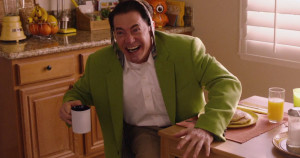 But also remember that Lynch wants us to wake up in THIS world, the real world. His puzzle films like Mulholland Drive reveal themselves to be lures to our desire to make connections, but we are meant to be spit out the other side with a renewed clarity that none of it is real, that it’s “all a recording.” He has planted a million little puzzles in Twin Peaks—we’ll all be poring over this for years—but the ultimate aim I’m sure is to bring us out the other side of our interpretive quest when we realize, with a kind of shock, that it is all a show.
But also remember that Lynch wants us to wake up in THIS world, the real world. His puzzle films like Mulholland Drive reveal themselves to be lures to our desire to make connections, but we are meant to be spit out the other side with a renewed clarity that none of it is real, that it’s “all a recording.” He has planted a million little puzzles in Twin Peaks—we’ll all be poring over this for years—but the ultimate aim I’m sure is to bring us out the other side of our interpretive quest when we realize, with a kind of shock, that it is all a show.
Thus I wouldn’t be surprised if there is some slap-you-in-the-face “Club Silencio” type scene before we are through, driving this point home. To an extent, the Roadhouse concerts sort of play that role: They break the fourth wall in a sense and create a bridge to the real world. I like to think, though, that in the last episode, the actors will all break character and appear on the dancefloor of the Roadhouse, as themselves, like the awesome celebratory end credits in Inland Empire.
The Devil Will Find Work for Idle Arms to Do
Lynch’s favorite symbol for what roots us in evil and suffering and ignorance is arms. We’ve known explicitly since Fire Walk With Me that Bob possesses people through their arms: Their arms go numb before they become his vessels. The one-armed man, remember, cut off his own arm to escape his possession by Bob’s evil companion in killing, Mike. I think arms are Lynch’s way of showing the idea of clinging/grasping as what holds us back from the good, and keeps us on the surface of life, preventing us from diving deep.
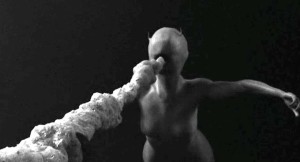 By this logic, the one-armed-man’s recalled self-amputation (from the original series) seems to represent “getting rid of grasping/clinging,” a great metaphor that every ancient Zen teacher still flickering on some eternal Chinese mountainside undoubtedly wishes he thought of. Also, recall how Laura Palmer said that sometimes her arms bend back, which we all thought was a reference to Bob (as her father Leland) tying her up in the train car where he raped and killed her … but now we have a new meaning: The supremely evil vomiting spirit mother’s arms are on backwards (something I only noticed when I looked closely at the still reproduced here). This seems like another kind of perversion of desire or attachment.
By this logic, the one-armed-man’s recalled self-amputation (from the original series) seems to represent “getting rid of grasping/clinging,” a great metaphor that every ancient Zen teacher still flickering on some eternal Chinese mountainside undoubtedly wishes he thought of. Also, recall how Laura Palmer said that sometimes her arms bend back, which we all thought was a reference to Bob (as her father Leland) tying her up in the train car where he raped and killed her … but now we have a new meaning: The supremely evil vomiting spirit mother’s arms are on backwards (something I only noticed when I looked closely at the still reproduced here). This seems like another kind of perversion of desire or attachment.
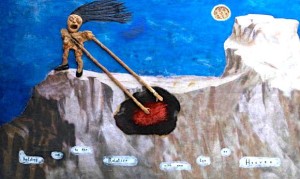 Lynch is obsessed with arms in his paintings as well: One of his lithographs is “Arm of Sores,” for instance, and many of his paintings such as “Boy Lights Fire” or “Pete Goes to His Girlfriend’s House” have evil figures with greatly elongated arms, doing or about to do mischief. And there is “Holding on to the Relative with One Eye on Heaven” (shown here).
Lynch is obsessed with arms in his paintings as well: One of his lithographs is “Arm of Sores,” for instance, and many of his paintings such as “Boy Lights Fire” or “Pete Goes to His Girlfriend’s House” have evil figures with greatly elongated arms, doing or about to do mischief. And there is “Holding on to the Relative with One Eye on Heaven” (shown here).
The neuron-like arm-tree in the Black Lodge, “the evolution of the arm,” on one hand seems to symbolize “making connections” (which we can connect to A.X.X.O.N.N. in Inland Empire)—and his/its role in Episode 7 makes this clear: It appears precisely to remind Dougie/Cooper of his FBI self-defense training: “squeeze his hand off.” In other words: reminding you of something you already know but just haven’t “made the connection.” The scary psychopath Ike the Spike clearly has “gripped too tightly” since the police have to peel his skin off the pistol grip after he flees the scene.
Lest we read too much into the arm’s “evolution,” however, remember that it was dictated principally by the refusal of Michael J. Anderson to reprise his role as the Man From Another Place (a.k.a. “dancing dwarf,” a.k.a. “Mike’s arm”) due to some personal dispute with Lynch. It’s too bad, he had much more personality than the tree, and was a better dancer.
When Will Bowie Show Up?
This is more a fan hope than a fan theory, but I think Lynch’s indirect denials to the contrary, it is altogether possible that David Bowie will show up late in the series reprising his role as Philip Jeffries, the FBI agent who disappeared in Buenos Aires after investigating someone named Judy. Lynch was able to film Catherine Coulson (the Log Lady), who was also dying of cancer and who died months before Bowie did. It would be just like the two Davids, the two greatest American artists of our time (I sort of consider Bowie American), to pull a surprise like this. Fans will go nuts. Bowie would have realized that, and being so concerned with legacy and sending a message to the future, would have done whatever he could to pop up as a surprise in Lynch’s show. These men, of all people, would have made it happen if they could.
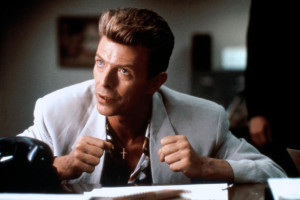 An added hunch: If Bowie does appear, it will be in Episode 15, the day before the big eclipse, and there may be additional Blackstar allusions or tie-ins. Remember that that song also is about a spirit rising from a dead body and being replaced by another; and remember that the video featured a headless skeleton floating in space. Twin Peaks seems to be “going there” in all kinds of ways, including the headless corpse of Major Briggs (possibly after a UFO journey that caused him to not age) and the various references to Jeffries and calls to a transforming black box in Buenos Aires, where Jeffries was last seen.
An added hunch: If Bowie does appear, it will be in Episode 15, the day before the big eclipse, and there may be additional Blackstar allusions or tie-ins. Remember that that song also is about a spirit rising from a dead body and being replaced by another; and remember that the video featured a headless skeleton floating in space. Twin Peaks seems to be “going there” in all kinds of ways, including the headless corpse of Major Briggs (possibly after a UFO journey that caused him to not age) and the various references to Jeffries and calls to a transforming black box in Buenos Aires, where Jeffries was last seen.
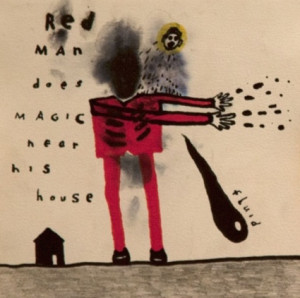 I’ve been getting a “Blackstar vibe” from this series in other ways: Lynch has been signaling his interest in ritual magic in his paintings for a few years now (see the 2013 painting at left, for instance, “Red Man Does Magic Near His House”), and though it hasn’t yet surfaced in his films, we were treated to a big time evil ritual over the wounded Evil Cooper/Bob in Episode 8, and we may see more of the same as the series progresses. That the savior of humanity from the likes of Bob might be ultimately in the hands of women (the message of Bowie’s “Blackstar” video, i.e. a ritual replacing “ISIS” and its various dark masculine permutations with Isis the goddess) seems likely in Twin Peaks too. If the 1956 girl is the vessel for the good Giant from the Purple Planet (versus the vessel for Bob or one of his fellows, see above), perhaps she will play some savior role. Whatever the case, the series certainly seems to be taking an epic direction.
I’ve been getting a “Blackstar vibe” from this series in other ways: Lynch has been signaling his interest in ritual magic in his paintings for a few years now (see the 2013 painting at left, for instance, “Red Man Does Magic Near His House”), and though it hasn’t yet surfaced in his films, we were treated to a big time evil ritual over the wounded Evil Cooper/Bob in Episode 8, and we may see more of the same as the series progresses. That the savior of humanity from the likes of Bob might be ultimately in the hands of women (the message of Bowie’s “Blackstar” video, i.e. a ritual replacing “ISIS” and its various dark masculine permutations with Isis the goddess) seems likely in Twin Peaks too. If the 1956 girl is the vessel for the good Giant from the Purple Planet (versus the vessel for Bob or one of his fellows, see above), perhaps she will play some savior role. Whatever the case, the series certainly seems to be taking an epic direction.
If Bowie appears, he might have also reserved a new unreleased song to appear in Lynch’s series (and its much anticipated soundtrack album), so I would expect some other performer (perhaps one of the cast of Lazarus?) to perform it at the Roadhouse.
Again, this is fan hope as much as fan theory, but I’m keeping my arm’s fingers crossed.
I’ll update this post as new information emerges, as readers chime in (please chime in), and most likely as I’m proved wildly wrong.
Postscript: Arms Don’t Bend Back
The question of arms and how they properly behave happened to be central to the Satori (enlightenment) experience of Zen writer and teacher Daisetz Suzuki, who brought Zen to America in the middle decades of the last century. In an autobiographical essay he described that his initial kensho, or a kind of luminous awakening attained after intense koan meditation, was only deepened and solidified by a second, subsequent realization some days later: that arms do not bend back:
After kensho, I was still not fully conscious of my experience. I was still in a kind of dream. The greater depth of realization came later … when suddenly the Zen phrase hiji soto ni magarazu, “the elbow does not bend outwards,” became clear to me. “The elbow does not bend outwards” might seem to express a kind of necessity, but suddenly I saw that this restriction was really freedom, the true freedom, and I felt that the whole question of free will had been solved for me.
This kind of “duh” realization about something as simple as the elbow joint is a distinctive Zen experience. It expresses exactly what I was getting at in my previous post, about the paradoxical freedom that comes from the limitation implied by the Minkowski block universe. Enlightenment comes from this kind of revelatory awareness of physical limitation, while ignorance (and darkness) is its denial … as in Lynch’s evil arm perversions.
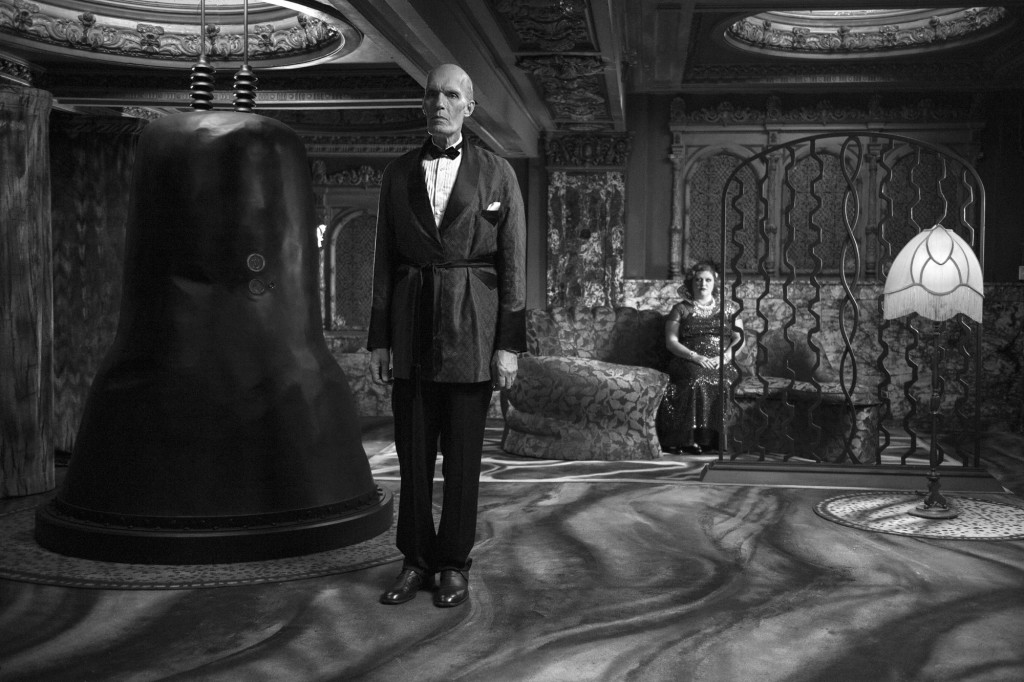
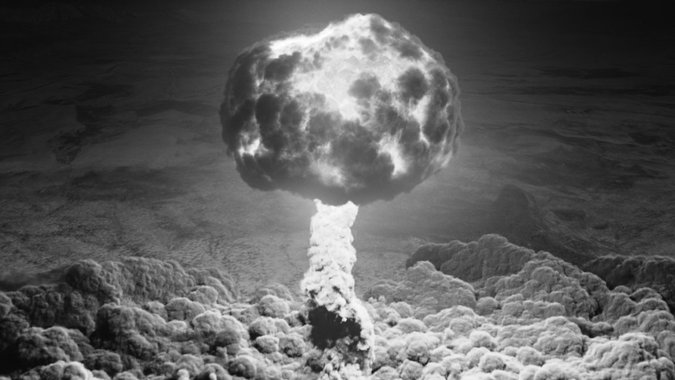






Haven’t watched it yet.